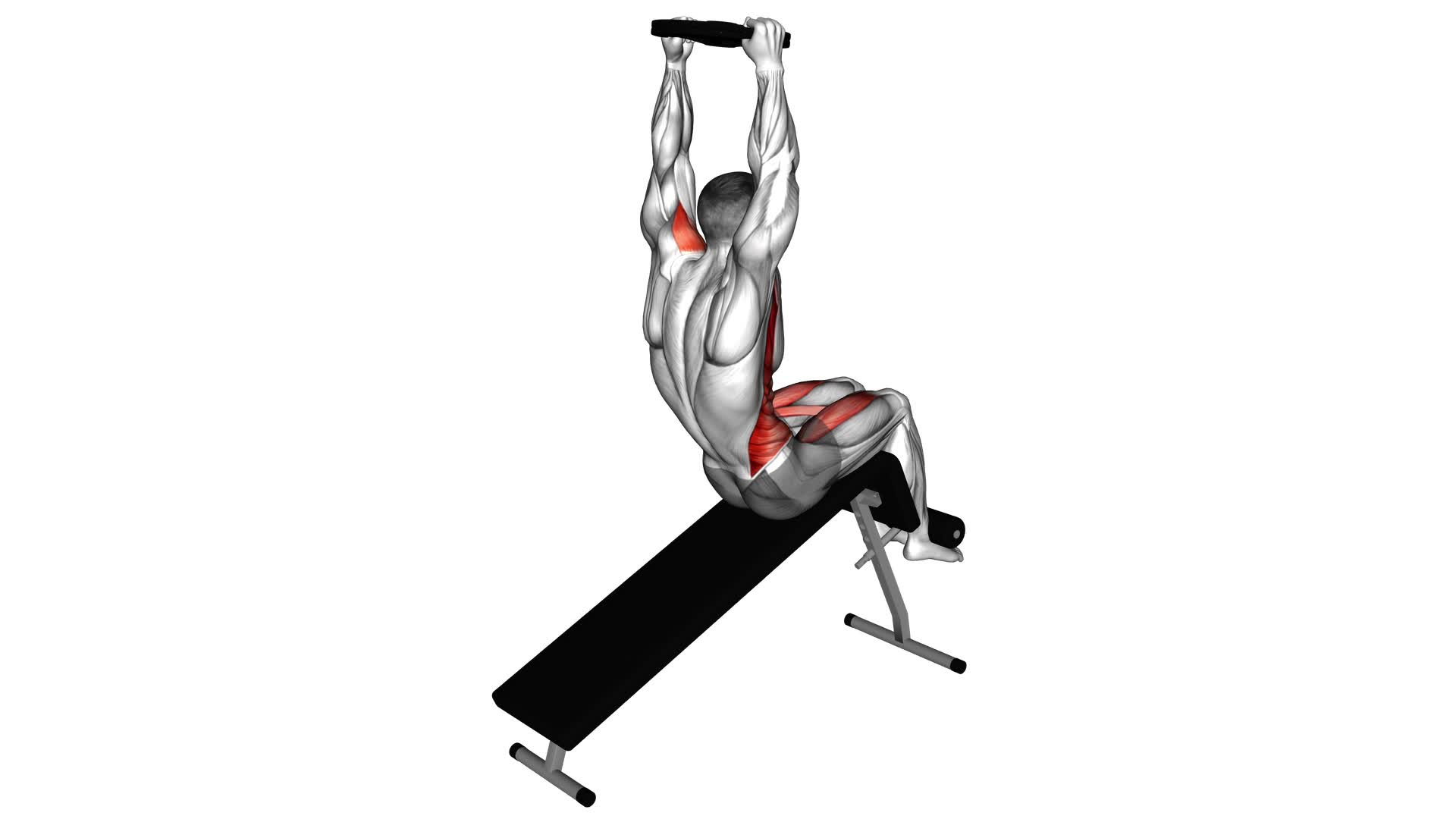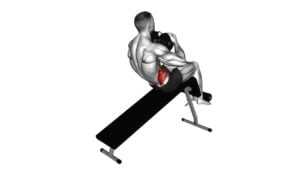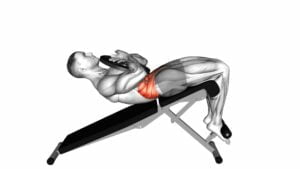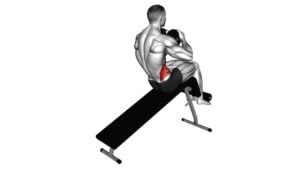Weighted Decline Sit-up – Video Exercise Guide & Tips

Get ready to strengthen your core with the weighted decline sit-up!
Watch This Exercise Video
This video exercise guide and tips will help you perfect your form and get the most out of this challenging move.
With just a few simple equipment and a little bit of determination, you'll be on your way to a stronger and more defined midsection.
Say goodbye to common mistakes and hello to a more effective workout.
Let's dive in and get those abs working!
Key Takeaways
- Weighted decline sit-ups target core muscles more effectively than traditional sit-ups.
- Engaging other muscle groups like hip flexors, lower back, and obliques.
- Weighted decline sit-ups help improve overall core strength and posture.
- Gradually increasing weight and adjusting the decline bench angle can intensify the exercise and challenge the muscles.
Benefits of Weighted Decline Sit-up
To fully maximize your core strength and achieve defined abs, incorporating weighted decline sit-ups into your workout routine is essential. The benefits of weighted decline sit-ups are numerous.
Firstly, this exercise specifically targets your core muscles, activating them to a greater extent than traditional sit-ups. The decline angle increases the resistance placed on your core, forcing it to work harder and leading to better results. By adding weights to your decline sit-ups, you increase the intensity of the exercise, further challenging your core muscles and promoting muscle growth.
In addition to core activation, weighted decline sit-ups also engage other muscle groups such as your hip flexors, lower back, and obliques. These muscles play a crucial role in stabilizing your torso and maintaining good posture. By strengthening them through weighted decline sit-ups, you not only improve your overall core strength but also enhance your ability to perform other exercises and daily activities.
Furthermore, incorporating weighted decline sit-ups into your routine can help you achieve a more defined and sculpted midsection. By targeting the deep abdominal muscles, this exercise aids in tightening and toning your abs, resulting in a more chiseled appearance.
Now that you understand the benefits of weighted decline sit-ups, let's move on to the equipment needed for this exercise.
Equipment Needed for Weighted Decline Sit-up
To perform a weighted decline sit-up, you'll need a few essential pieces of equipment. Firstly, you'll need a decline bench that can be adjusted to different angles. This will provide the necessary support and stability during the exercise.
Additionally, you'll need a weight plate or dumbbell to add resistance to the sit-up movement.
If you don't have access to a decline bench, you can modify the exercise by using an exercise ball or performing decline sit-ups on a flat surface without any incline.
Essential Equipment for Weighted Decline Sit-Up
You will need specific equipment for the weighted decline sit-up. Here are the essential items you should have:
- Decline Bench: This is the main equipment needed for the weighted decline sit-up. It's a bench that can be adjusted to different angles to create the decline position.
- Weight Plates or Dumbbells: To add resistance to your sit-ups, you'll need weight plates or dumbbells. Start with a weight that challenges you but allows you to maintain proper form.
- *Weighted Decline Sit-Up Variations*: Depending on your fitness level and goals, you can choose different variations of weights, such as using a single weight plate held close to your chest or holding dumbbells at your sides.
- *How to Choose the Right Weight for Weighted Decline Sit-Up*: Start with a lighter weight and gradually increase as you get stronger. Aim for a weight that challenges you but still allows you to complete the desired number of reps with good form.
Having the right equipment for the weighted decline sit-up will ensure that you can perform the exercise safely and effectively.
Alternatives to Weighted Decline Sit-Up
If you're looking for alternatives to the weighted decline sit-up, there are a few options that require minimal equipment.
One effective alternative is the Russian twist. To do this exercise, sit on the floor with your knees bent and feet flat. Lean back slightly, keeping your back straight and core engaged. Hold a weight or medicine ball with both hands and twist your torso from side to side, touching the weight or ball to the floor on each side.
Another alternative is the plank. Get into a push-up position and lower yourself onto your forearms. Keep your body straight and hold this position for as long as you can.
Both of these exercises target the core muscles and can be done without the need for a decline bench or any additional equipment.
Proper Form and Technique for Weighted Decline Sit-up
To perform the weighted decline sit-up with proper form and technique, it's important to focus on core muscle activation, utilize the right equipment and modifications, and avoid common mistakes.
Engage your core muscles throughout the exercise to maximize the benefits and prevent strain on your lower back.
Use a weight plate or dumbbell to add resistance and challenge your abdominal muscles.
Be cautious of swinging your arms or using momentum to lift your upper body, as this can diminish the effectiveness of the exercise.
Core Muscle Activation
Regularly performing weighted decline sit-ups with proper form and technique activates the core muscles effectively. This exercise is an excellent way to engage your core and reap the benefits of core training. Here are some key points to consider:
- Core Muscle Activation:
- Weighted decline sit-ups specifically target the rectus abdominis, obliques, and transverse abdominis.
- The decline angle increases the difficulty and intensifies the activation of these muscles.
- Benefits of Core Training:
- Strengthening your core improves stability and balance.
- It enhances overall athleticism and performance in other activities.
- A strong core helps prevent injuries and supports proper posture.
By understanding the core muscle activation and the benefits of core training, you can maximize the effectiveness of your weighted decline sit-ups.
Now, let's move on to the next section, where we'll discuss equipment and modifications for this exercise.
Equipment and Modifications
To optimize your weighted decline sit-up, consider the equipment and modifications that can improve your form and technique. Using the proper equipment and modifications can enhance the effectiveness of the exercise and help prevent injury.
One advanced technique is to use a weight plate or dumbbell to increase the resistance. This can be placed on your chest or held behind your head to challenge your core muscles even further.
Another modification is to adjust the decline bench angle. By increasing the decline, you can increase the difficulty of the exercise.
Additionally, using a stability ball instead of a decline bench can engage more stabilizer muscles and add an extra challenge to the exercise.
Experiment with these equipment modifications and advanced techniques to take your weighted decline sit-up to the next level.
Common Mistakes to Avoid
Avoid these common mistakes to ensure proper form and technique for the weighted decline sit-up.
- Incorrect spinal alignment
- Arching your back or rounding your shoulders can put unnecessary strain on your spine. Keep your back straight and shoulders relaxed throughout the exercise.
- Injury prevention: Maintaining proper spinal alignment helps prevent back injuries and ensures effective engagement of your abdominal muscles.
- Using momentum
- Swinging your body or using jerky movements reduces the effectiveness of the exercise and increases the risk of injury.
- Injury prevention: Slow and controlled movements engage your core muscles properly and minimize the risk of muscle strains.
By avoiding these mistakes, you can perform the weighted decline sit-up with proper technique, reducing the risk of injury and maximizing the benefits of the exercise.
Now, let's explore the variations and progressions of the weighted decline sit-up.
Variations and Progressions of Weighted Decline Sit-up
To challenge yourself and make progress with the weighted decline sit-up, try incorporating variations and progressions into your workout routine. By adding different variations to this exercise, you can target different muscles and keep your routine interesting.
One variation you can try is the Russian twist with a weighted decline sit-up. This adds an element of rotation to the exercise, engaging your obliques and improving core stability.
Another variation is the weighted decline sit-up with a medicine ball toss. This not only strengthens your abs but also works on your upper body strength and coordination.
To progress with the weighted decline sit-up, you can increase the weight of the dumbbell or medicine ball that you're using. You can also increase the difficulty by adding more repetitions or sets to your workout.
Additionally, you can try performing the exercise on an unstable surface, such as a stability ball, to further challenge your core stability and balance.
Remember to always maintain proper form and listen to your body to avoid injury.
Incorporating these variations and progressions will help you continue to challenge yourself and see improvements in your strength and fitness level.
Common Mistakes to Avoid During Weighted Decline Sit-Up
One common mistake to avoid during the weighted decline sit-up is using improper form. Proper form is essential for maximizing the benefits of this exercise and reducing the risk of injury. Here are some common mistakes to avoid:
- Improper breathing: Many people tend to hold their breath during exercises, but proper breathing is crucial for optimal performance. Remember to exhale as you contract your abdominal muscles and inhale as you return to the starting position. This helps to engage your core effectively and maintain stability throughout the movement.
- Improper foot placement: Placing your feet in the wrong position can lead to strain on your lower back and reduce the effectiveness of the exercise. Make sure your feet are securely anchored under the provided foot pads and your knees are bent at a 90-degree angle. This position helps to stabilize your body and engage your core muscles properly.
By avoiding these common mistakes and focusing on proper breathing and foot placement, you'll ensure that you're getting the most out of your weighted decline sit-up routine.
Now, let's move on to the next section to learn some tips for maximizing your results.
Tips for Getting the Most Out of Weighted Decline Sit-Up
To maximize your results with the weighted decline sit-up, focus on proper form and engage your core muscles throughout the movement. This exercise not only targets your abs but also works your hip flexors, lower back, and obliques.
Here are some tips to help you get the most out of your weighted decline sit-ups:
- Improve stability: Before adding weight, make sure you have mastered the basic decline sit-up without any equipment. This will help you build a strong foundation and improve your stability. Once you feel comfortable, start by using a light weight and gradually increase the resistance.
- Engage your core: Throughout the exercise, keep your core muscles engaged by pulling your belly button towards your spine. This will help you maintain stability and prevent any strain on your lower back.
- Control the movement: Avoid using momentum to lift yourself up. Instead, focus on using your abdominal muscles to perform a controlled and deliberate movement. This will ensure that you're targeting the right muscles and maximizing the effectiveness of the exercise.
- Breathe properly: Exhale as you lift your upper body and inhale as you lower yourself back down. Proper breathing technique will help you maintain control and stability during the exercise.
Frequently Asked Questions
How Many Sets and Reps Should I Do for Weighted Decline Sit-Ups?
To determine how many sets and reps you should do for weighted decline sit-ups, consider your fitness level and goals. Start with 2-3 sets of 10-12 reps and gradually increase as you get stronger. Remember to maintain proper form and breathe throughout the exercise.
Weighted decline sit-ups offer various benefits, such as strengthening your core muscles, improving stability, and increasing overall abdominal strength. Experiment with different variations to challenge your muscles and keep your workout routine engaging.
Can I Do Weighted Decline Sit-Ups if I Have Lower Back Pain?
If you have lower back pain, it's important to consult a healthcare professional before attempting weighted decline sit-ups. They may recommend alternative exercises that won't aggravate your condition.
However, if you're pain-free and have proper form, weighted decline sit-ups can strengthen your core muscles, improve stability, and increase abdominal strength.
Remember to start with lighter weights and gradually increase to avoid strain on your lower back.
What Muscles Does the Weighted Decline Sit-Up Primarily Target?
The weighted decline sit-up primarily targets your abdominal muscles, specifically the rectus abdominis. This exercise can help strengthen your core and improve your overall stability.
It's important to incorporate weighted decline sit-ups into your workout routine to challenge your muscles and promote muscle growth. However, be cautious and avoid common mistakes such as using too much weight or straining your lower back.
Focus on maintaining proper form and gradually increase the weight as you become stronger.
Is It Safe to Use a Dumbbell or Kettlebell for Added Weight During the Exercise?
Using a dumbbell or kettlebell for added weight during the weighted decline sit-up can be a safe and effective way to intensify your workout. It helps to target and strengthen your abdominal muscles even more.
However, it's important to maintain proper form and technique to avoid strain or injury. Make sure to keep your back flat against the bench, engage your core, and use controlled movements throughout the exercise.
Always start with a weight that you can handle comfortably and gradually increase as you get stronger.
Can I Substitute the Decline Bench With an Incline Bench for the Exercise?
Yes, substituting the decline bench with an incline bench for the exercise is a viable option. Using different bench angles for sit-ups can provide various benefits.
The incline bench targets the upper abdominal muscles more intensely, while the decline bench focuses on the lower abs. This variation helps to engage and strengthen different areas of the core.
Conclusion
In conclusion, the weighted decline sit-up is a highly effective exercise for strengthening your core muscles. By adding resistance, you can increase the intensity and challenge of this exercise. Remember to maintain proper form and technique to avoid injury and maximize results.
Additionally, try different variations and progressions to keep your workouts interesting and continue making progress. Avoid common mistakes and follow these tips to get the most out of your weighted decline sit-up routine.

Author
Years ago, the spark of my life’s passion ignited in my mind the moment I stepped into the local gym for the first time. The inaugural bead of perspiration, the initial endeavor, the very first surge of endorphins, and a sense of pride that washed over me post-workout marked the beginning of my deep-seated interest in strength sports, fitness, and sports nutrition. This very curiosity blossomed rapidly into a profound fascination, propelling me to earn a Master’s degree in Physical Education from the Academy of Physical Education in Krakow, followed by a Sports Manager diploma from the Jagiellonian University. My journey of growth led me to gain more specialized qualifications, such as being a certified personal trainer with a focus on sports dietetics, a lifeguard, and an instructor for wellness and corrective gymnastics. Theoretical knowledge paired seamlessly with practical experience, reinforcing my belief that the transformation of individuals under my guidance was also a reflection of my personal growth. This belief holds true even today. Each day, I strive to push the boundaries and explore new realms. These realms gently elevate me to greater heights. The unique combination of passion for my field and the continuous quest for growth fuels my drive to break new ground.







